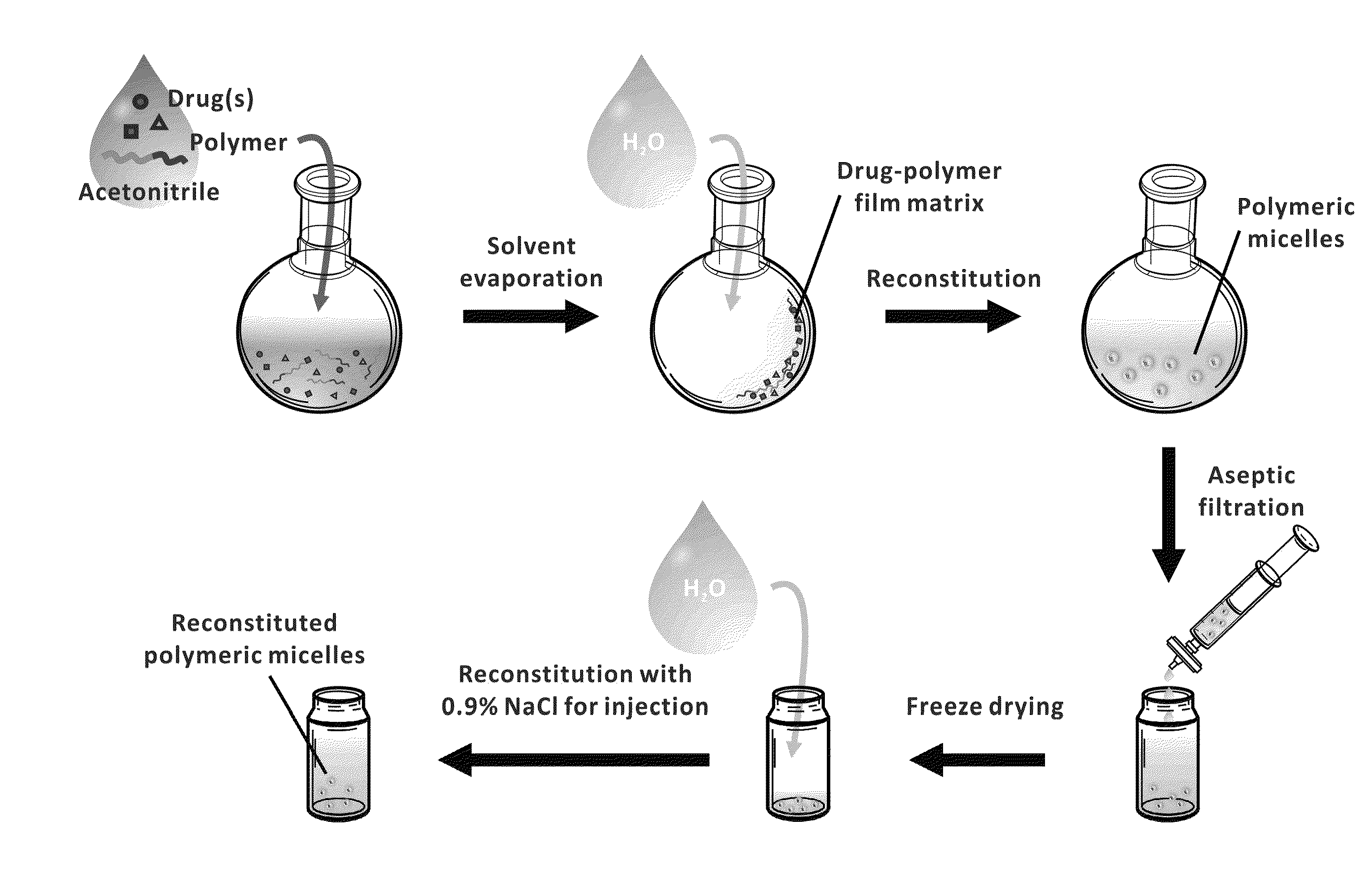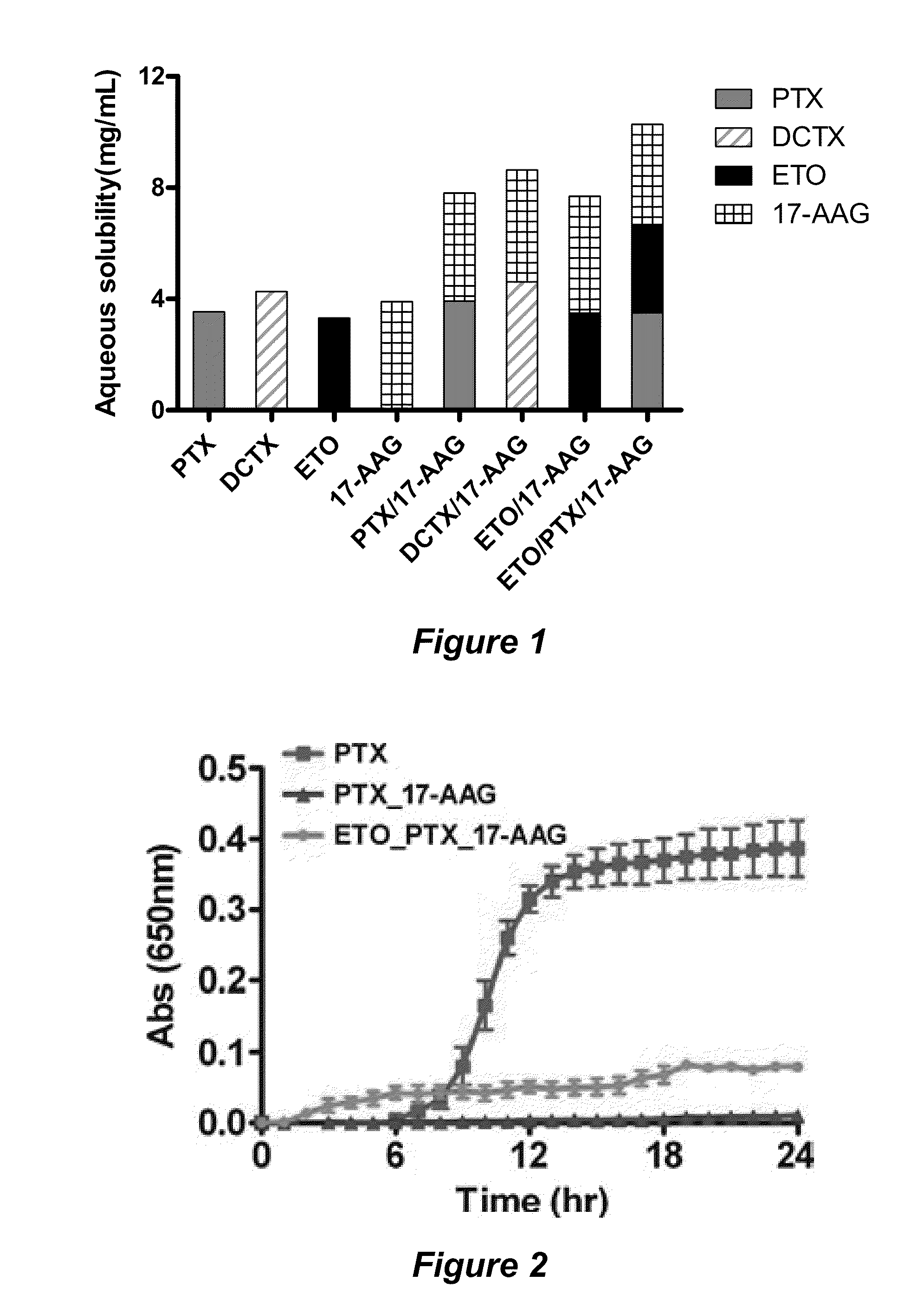Micelle encapsulation of therapeutic agents
a technology of therapeutic agents and micelles, which is applied in the field of micelles encapsulation of therapeutic agents, can solve the problems of significantly complicating the search for suitable delivery systems, single drug formulations providing only limited success, and chemotherapeutics currently in use are poorly water soluble, so as to increase the stability of the micelle, inhibit other points of enzyme pathways, and have synergistic anticancer activity
- Summary
- Abstract
- Description
- Claims
- Application Information
AI Technical Summary
Benefits of technology
Problems solved by technology
Method used
Image
Examples
example 1
17-AAG Encapsulation in PEG-b-PLA Micelles
[0112]Preparation of 17-(allylamino)-17-demethoxygeldanamycin. 17-AAG was synthesized in the lab from geldanamycin (GA) (LC Laboratories, Woburn, Mass.). Briefly, 100 mg of GA (0.2 mmol) was dissolved in 2 mL of dry CH2Cl2. Next, 5 equivalents of allylamine (57.1 g / mol, d=0.763 g / mL) was added dropwise to the flask. The reaction was stirred at room temperature (RT; ˜23° C.) under low light until complete by TLC analysis (approx. 2 days) (95:5 CHCl3:MeOH, Rf 0.21), precipitated with hexane (3×), centrifuged at 2000 g's for 15 minutes, and evaporated to dryness. Yield: 95 mg, 95%; MS m / z 584 (M−); 1H NMR (CDCl3) δ 0.99 (m, 6H, 10-Me, 14-Me), 1.25 (t, 1H, H-13), 1.60-1.85 (br m, 6H, H-13, H-14, 8-Me), 2.05 (s, 3H, 2-Me), 2.46 (br m, 2H, H-15), 2.83-2.90 (br m, 3H, H-10), 3.27 (s, 3H, OMe), 3.36 (s, 3H, OMe), 3.40 (t, 1H, H-12), 3.58-3.68 (br m, 2H, H-11, H-23), 4.31 (d, 1H, H-7), 5.10 (br s, 1H), 5.21-5.55 (br m, 3H, H-9, H-24), 5.86-5.99 (br t...
example 2
Drug Solubilization; Reference Examples
[0117]Several polymers that form micelles with drugs were surveyed for solubilizing a paclitaxel-rapamycin-17-AAG drug combination. The combination proved difficult to solubilize without a correct set of micellar properties. For example, the PEG-PPG-PEG triblock polymer Poloxamer F68 is useful to solubilize many hydrophobic compounds such as resveratrol, a hydrophobic compound with reported anticancer activity. Poloxamer F68, however, was unable to solubilize paclitaxel, rapamycin, or 17-AAG individually, or the combination of paclitaxel, rapamycin, and 17-AAG. In these attempts, the micelles coagulated and deteriorated in aqueous solutions.
[0118]Conversely, PEG-b-PLA does not form stable micelles when combined with resveratrol, but does form very stable micelles with both 17-AAG and the paclitaxel-rapamycin-17-AAG drug combination. Additionally, the tri-drug loaded PEG-b-PLA micelles display remarkable properties by solubilizing the drugs in a...
example 3
Multi-Drug Loaded Polymeric Micelles for Simultaneous Delivery of Poorly Soluble Anticancer Drugs
[0125]PEG-b-PLA, an amphiphilic block copolymer, assembles readily in water into micelles. It has been shown to raise the solubility of paclitaxel (PTX) from approximately 1 μg / mL to 10 mg / mL. PEG-b-PLA is much less toxic than CrEL. However, a recent phase II clinical trial in metastatic breast cancer patients showed that PTX dosed as part of PEG-b-PLA micelles, without premedication with corticosteroids and histamine antagonists, does induce hypersensitivity reactions, albeit less severely than CrEL. PEG-b-PLA micelles increase the maximum tolerated dose of PTX in humans in comparison to CrEL, enhancing its anti-tumor efficacy. There is also evidence that PEG-b-PLA micelles impart linear PK for PTX, strongly contrasting with CrEL that induces a non-linear PK profile for PTX, i.e. lowering its clearance with dose escalation. Using these PEG-b-PLA micelles to raise the solubility of vario...
PUM
| Property | Measurement | Unit |
|---|---|---|
| wt. % | aaaaa | aaaaa |
| concentration | aaaaa | aaaaa |
| solubility | aaaaa | aaaaa |
Abstract
Description
Claims
Application Information
 Login to View More
Login to View More - R&D
- Intellectual Property
- Life Sciences
- Materials
- Tech Scout
- Unparalleled Data Quality
- Higher Quality Content
- 60% Fewer Hallucinations
Browse by: Latest US Patents, China's latest patents, Technical Efficacy Thesaurus, Application Domain, Technology Topic, Popular Technical Reports.
© 2025 PatSnap. All rights reserved.Legal|Privacy policy|Modern Slavery Act Transparency Statement|Sitemap|About US| Contact US: help@patsnap.com



